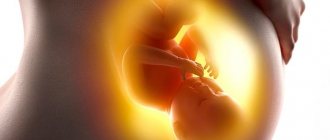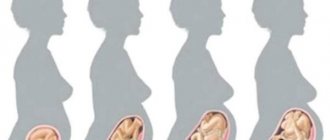Childbirth is a significant event for a woman’s body, stimulating the restructuring of her reproductive system. Considering that ovulation did not occur during 40 weeks of pregnancy and now for its occurrence it is necessary to begin coordinated work of the brain and ovaries.
Previously, 4 hormones worked in different phases of the menstrual cycle: follicle-stimulating hormone (FSH), estrogen, luteinizing hormone (LH) and progesterone, now in women who are breastfeeding, they have been joined by a fifth hormone - prolactin, which ensures normal lactation (breast milk secretion).
The postpartum period “postpartum” is the final stage of the entire pregnancy, occurring immediately after the birth of the placenta and lasting 6 and sometimes 8 weeks.
Based on the time elapsed after childbirth, there are 2 types of the postpartum period:
- early (next 2 hours;
- late (after transfer to the postpartum department).
Let us remember that ovulation is the rupture of the main mature follicle, with the release of an egg into the abdominal cavity, and then into the fallopian tube. If the egg is not fertilized within 24 hours, it dies. With an established menstrual cycle, if it is 28 days, then ovulation occurs on the 12-14th day, if it is 21 days, then on the 9-11th day, and if it is 30-35 days, on the 15-17th day. y.
There are two phases in the menstrual cycle, the first is the follicular phase, accompanied by a gradual increase in estrogen in the blood and the growth of the follicle, then ovulation occurs and the second phase is the luteal phase, during which the corpus luteum is formed and progesterone in the blood increases.
During pregnancy, ovulation does not occur, because under the influence of pregnancy hormones, and in particular human chorionic gonadotropin (hCG) and progesterone, follicles do not mature, and, accordingly, ovulation does not occur.
Ovulation after childbirth can occur after 1.5 months, but it will not always lead to menstruation.
Note! Ovulation is one of the main conditions for pregnancy.
Changes in the female reproductive system after childbirth
During the postpartum period, a woman's body undergoes various changes. The mammary glands increase in size throughout the entire period of pregnancy, after childbirth, lactation begins (secretion of breast milk) with colostrum (the first thick and fatty milk), which is released in small quantities, then breast milk becomes less dense and released in large quantities.
Lactation is an energy-consuming process; it consumes 500 kcal per day, so during this period a woman should eat a balanced, rational diet in accordance with her energy needs. For normal production of breast milk, a normal level in the blood of the hormone that stimulates its production, prolactin, is necessary.
The influence of women's health on ovulation
The rhythm and duration of ovulation depends on several factors that are directly related to the state of women’s health and can change in the following cases:
- the beginning stage of menopause;
- previous abortion;
- the next 6-12 months after the birth of the child.
The process of egg development stops during the period of bearing a child, as well as at the time of the appearance of menopausal symptoms, when processes that precede age-related changes occur in the body.
The onset and course of the menstrual cycle, and, accordingly, ovulation, undergo some changes in the process of recovery of the body after certain female diseases, during a certain period after an abortion, as well as for several months after childbirth.
The postpartum period is a special state of a woman when the body resumes reproductive function. Since most organs functioned in a slightly different mode during pregnancy, undergoing hormonal and physiological changes, they therefore require some time after childbirth to acquire their prenatal form. This applies to both the menstrual cycle and the onset of ovulation.
Kegel exercises
There are 3 parts of exercises to improve the tone of the perineal muscles:
- slow compressions: strain your muscles to stop urination, slowly count to 3, go into a relaxed state;
- fast contractions: repeat the same exercises, but at high speed;
- pushing or pushing, as during childbirth or defecation.
Each exercise is repeated 10 times and 5 times a day, after a week, not earlier, exercises are added to strengthen the abdominal press.
Signs of ovulation
Ovulation without menstruation during lactation in most cases goes unnoticed, but these processes in the female body can be indicated by characteristic symptoms, such as:
- the appearance of abundant vaginal discharge, which may be stringy, which will signal the rupture of the follicle and the release of the egg;
- discomfort in the abdominal cavity, aching pain in the lower abdomen;
- increased gas formation, flatulence;
- increased sensitivity and swelling of the breasts;
- increased sexual desire.
Women often attribute the above symptoms to general malaise, and therefore do not think about restoring the reproductive system during lactation.
Causes of pain during ovulation
At the moment of ovulation, the wall of the follicle becomes thinner and ruptures, given that this process has not occurred for 40 weeks, it may be accompanied by pain. Any ovulation is accompanied by a hormonal surge, to which the uterus primarily reacts, significantly overstretched during pregnancy, and at the time of the first ovulation it may not be ready, reacting to hormonal changes with spasmodic contractions.
Causes of abdominal pain before ovulation
Sometimes a woman worries that she is experiencing pain before ovulation, but in fact, due to physiological or pathological reasons, the moment of release of the egg occurred earlier, that is, in fact, she is now ovulating.
Physiological reasons for the shift in the ovulatory phase include: stress, acute illnesses and exacerbation of chronic pathologies, time zone changes. Ovulation can also shift due to inflammatory diseases, endometriosis, and endocrine diseases that have developed in the uterine appendages (pathologies of the adrenal glands, hypothalamus, pituitary gland).
If your stomach hurts before ovulation, and this is clearly visible from the basal temperature graph or folliculometry data, the symptom indicates the presence of various pathologies:
- growing uterine fibroids, manifested, in addition to constant pain, by bleeding from the vagina during the intermenstrual period, as well as longer and heavier menstruation;
- the development, immediately before the release of the oocyte, of inflammation of the uterine appendages (salpingoophoritis), intestines or urinary organs, each of which is complemented by characteristic symptoms.
Calculation and methods for determining ovulation after childbirth
The process of formation of the main follicle after childbirth takes from 1 to 2.5 months, regardless of whether the mother is breastfeeding or not. The first ovulation can occur 40-45 days after birth, which may not always lead to the formation of the corpus luteum, and therefore is sometimes not accompanied by menstruation.
Ovulation is determined by several methods, but the most proven are:
- Monitoring the basal temperature curve. To do this, every day, using a rectal thermometer, measure the temperature in the rectum and mark it on the graph; a sharp rise in temperature means ovulation.
- Ultrasound monitoring (folliculometry), this method determines the growth of follicles, as well as the rupture of the main follicle (ovulation).
- Monitoring the level of sex hormones in the blood is the most expensive, but at the same time reliable method. Estrogen levels increase significantly before ovulation, and progesterone levels after it.
- Examination of cervical mucus: “fern” symptom - crystallization of mucus under the influence of estrogens, at the time of ovulation the result looks like a leaf; a symptom of mucus tension, reaches up to 20 cm during ovulation, but is not detected after ovulation.
- Allergy tests with estrogen or progesterone. With an increased concentration of the hormone, a spot or infiltrate appears at the site of subcutaneous injection.
- Invasive methods (penetrating the body): hysteroscopy, laparoscopy and others. Rarely used.
Many methods are applicable after discharge from the maternity hospital.
Why does ovulation not occur after childbirth?
What influences whether ovulation occurs after childbirth or not? In addition to individual characteristics, breastfeeding is an important criterion.
Statistics say that the longer a woman breastfeeds her child, the later her reproductive functions will begin to recover. Why? With frequent breastfeeding, increased production of the hormone progesterone occurs. It is he who slows down the ovulation process and prevents menstruation from starting. For 6 months after giving birth, a woman who has milk puts her baby to her breast 3-4 times a day. In this case, you should not be surprised that she does not have an egg release. This is scientifically explained. However, after six months, young mothers begin to feed the baby purees and formulas, thereby putting the baby to the breast less. Accordingly, less milk is produced, and less hormones too. During this period, you can observe some signs of ovulation. And if the mother completely weans the child from the breast, then this process will not take long to happen.
Do not think that when ovulation occurs, your period will begin. They, as a rule, can come much later than ovulatory processes.
Treatment of pain during ovulation
Drug treatment. Pain during ovulation occurs due to inflammation caused by rupture of the follicle, so non-steroidal anti-inflammatory drugs are often recommended: Diclofenac, Ibuprofen, Nimesulide and others.
As mentioned above, ovulation is sometimes accompanied by painful contractions of the myometrium (muscular layer of the uterus); to reduce these symptoms, antispasmodics are used, the most famous drug is “No-shpa”. There are also combinations of these two groups of drugs. They should be used only according to the instructions for use.
Ovulation cannot be painful if it does not exist; hormonal contraception is used to suppress ovulation, and this is necessary to allow your body to recover after pregnancy.
Traditional methods of treatment.
These include the ingestion of various decoctions and infusions from raspberry leaves, lemon balm, valerian, as well as beet juice. To reduce pain, you can place a warm heating pad on the abdominal area.
Does childbirth affect ovulation?
Painful ovulation after childbirth is especially common in women who gave birth to a baby via cesarean section. Adhesions in the abdominal cavity cause pain.
The following reasons can also cause pain during the ovulation period after childbirth:
- The ovarian membrane becomes too dense, so the egg has to forcefully “break through” it;
- The dominant follicle is very large, so during the release of the egg, stretching or rupture of the ovary may occur.
It should be remembered that pain during ovulation in the postpartum period can be a signal of the development of serious gynecological diseases. Therefore, if the pain is severe and regular, you should consult a doctor to exclude the development of dangerous pathologies.
If the natural birth process has passed without complications, after stabilization of hormonal levels and restoration of the menstrual cycle, pain during ovulation no longer bothers women.
Complete restoration of the menstrual cycle
Taking into account the data of many studies, restoration of the function of hormonal regulation of the menstrual cycle occurs within a month after childbirth.
- Ovulation in non-lactating women. In 15% of women who do not breastfeed, ovulation occurs one and a half months after birth, and by the third month the rest of the non-breastfeeding women already have it.
- Ovulation during breastfeeding. After 6 weeks, ovulation is observed in 5% of women, and by the third month menstruation occurs in 20% and only in 2/3 the menstrual cycle is accompanied by menstruation. After six months, the normal menstrual cycle is restored in 85% of women.
If you want to get pregnant immediately after giving birth, consider these factors!
- According to WHO recommendations, a second pregnancy is desirable two years after the previous one. Previously, according to Soviet protocols, it was 3 years. Such a period is needed not only so that all the attention of the mother is directed to the baby. There are several other reasons to delay planning.
WHO recommends postponing a new pregnancy for 2 years so that the baby grows up and the mother recovers from prolonged stress
- The female body needs time to recuperate and replenish mineral losses during pregnancy. Rest of all systems and organs after double the load. Moreover, the most useful substances and microelements also leave with breast milk.
Every young mother wants to remain healthy, beautiful and blooming for as long as possible. Is it easy to replenish a depleted resource after a recent pregnancy, during lactation and, in addition, another pregnancy?
- More than breast milk, a baby needs her mother’s care, affection and love. Imagine if a woman, already under stress after childbirth, experiences new worries in connection with pregnancy. How to feed if breast milk goes rancid? How to protect yourself from tone if you have to constantly carry your baby in your arms? How to cope with everything in the world?
- We are all conscious women. Let's think about whether the body, already weakened by recent pregnancy and breastfeeding, will be able to provide everything necessary for a new tiny life. After all, our goal is not just to give birth, but to give birth to a healthy child.
Drugs to restore normal menstrual cycle
Hormonal drugs are used to restore the normal menstrual cycle, but self-medication with their use is highly discouraged. It is advisable to contact an obstetrician-gynecologist, and
Together with him, individually select a medicine.
Postpartum contraception
Women are known to be sexually active during the postpartum period. Ovulation, accompanied by increased libido, abstinence in the early postpartum period, as well as psychological characteristics associated with the birth of a child, encourages both partners to engage in sexual intercourse. Myths associated with the inability to get pregnant during lactational amenorrhea lead to the fact that 15% of partners do not use contraception.
Lactational amenorrhea can be used as a method of contraception, but subject to proper adherence to certain breastfeeding rules (intervals of at least 2-2.5 hours, exclusive breastfeeding, child under 6 months), to maintain sufficient levels of prolactin, which suppresses ovulation.
Among the methods of hormonal contraception, the following are used: oral progestin, intrauterine devices (1-2 months after restoration of the size of the uterus), combined estrogen-gestagen drugs (no earlier than six months after childbirth), in rare cases, emergency contraception is used, which is also used no earlier than than in 1 month.
Do not underestimate barrier methods of contraception; their combination with hormonal agents is considered the most reliable method.
How to determine pregnancy while breastfeeding
Signs of pregnancy are completely individual and may differ with each new case. During lactation, the difference in milk is most often noticeable:
- the baby eats less, reluctantly, and is capricious;
- milk comes in less often;
- the breasts have become larger, tense, but there is the same amount of milk;
- the halos around the nipples have darkened;
- unusual pain appeared while feeding the baby.
Have you noticed such changes? Take an ultra-sensitive pregnancy test.
Advice(!) To maintain lactation, do not supplement your baby’s feeding if he is under 6 months old. Try breastfeeding more often; soon the baby will get used to the changed taste of milk and will gain weight as before. After starting complementary feeding, continue feeding. Relax and think about good things! With time everything will get better.
During pregnancy with breastfeeding, in order to maintain lactation, it is very important to think about the good!
Other probable, but optional, signs of pregnancy during breastfeeding
Remember, old symptoms do not necessarily recur in a new pregnancy. They may be completely different. Here is a list of the main, most frequently recurring symptoms:
- Toxicosis – nausea, drooling, belching, unpleasant taste in the mouth;
- Abnormal stool – constipation and flatulence;
- Emotionality, changeable mood;
- Aching in the lower abdomen, pulling in the lower back;
- Frequent urination;
- The appetite disappeared for no reason or, conversely, brutal hunger appeared;
- Unexpected sensitivity to odors;
- Weakness, fatigue and weakness.
- Symptoms of a cold without a cold: slightly elevated body temperature (37-37.4), stuffy nose.
In principle, all these same signs are possible during normal pregnancy without lactation. The earliest symptoms and diagnostic methods are described in great detail in this article. If you notice some of them, you can “soak” the test!
Be positive and everything will work out for you!
If you find an error, please select a piece of text and press Ctrl+Enter.
Having become a happy mother, a woman most often does not think about when her menstrual cycle will return to normal and ovulation will occur, which ensures the restoration of the reproductive functions of the female body.
Ignoring this issue is fraught with the onset of pregnancy, which immediately after the birth of a long-awaited child may turn out to be unwanted. By studying information about how the menstrual cycle is restored after childbirth, you will be able to avoid such problems.
How to protect yourself from pregnancy while breastfeeding
When choosing a method of contraception, you should definitely consult your doctor. There are several reliable methods of contraception that are available to breastfeeding women:
- birth control pills;
- candles;
- condoms;
- spiral.
Read more about contraceptive methods in the article - Suitable contraceptive methods for a nursing mother.
Birth control pills (oral contraceptives)
During the lactation period, only so-called mini-pills are allowed. They contain only the hormone progestin, which does not affect breast milk. Such drugs are prescribed 2–3 months after birth. The effectiveness of this method of protection when used correctly is 98%.
Only the attending physician should select oral contraceptives
Pregnancy suppositories
Pregnancy suppositories are kispermicides. The effectiveness of these drugs is 90%. Their action is to destroy the membrane of spermatozoa and, as a result, to their destruction. They can be used immediately after childbirth. The effect lasts up to six hours after application.
Condoms
Condoms are the safest method of protection for the health of both the baby and the mother. Its effectiveness is up to 97%. However, it is necessary to choose only quality products and use the condom correctly to prevent it from breaking or slipping during intercourse.
Spiral after childbirth
Insertion of the IUD after childbirth without complications is possible within six weeks. Its advantage over other methods of protection lies in the duration of use. After administration, the effect lasts up to 7 years. The duration of each spiral depends on its type. The effectiveness of this method of contraception is 98–100%.
How to terminate a pregnancy while breastfeeding
Termination of pregnancy during breastfeeding is possible by two methods: surgical or medicinal. The purpose of this or that method of interruption should be determined by the doctor. It is possible to maintain breastfeeding with both types of abortion. But for the safety of the baby and mother, you should discuss with your doctor whether it is necessary to postpone feeding for a while or whether you can continue to put the baby to the breast as before. If, nevertheless, it was prescribed to temporarily stop breastfeeding, maintaining lactation is possible through frequent pumping.
General condition after childbirth and when you can get pregnant
As soon as the long-awaited baby was born, the mother’s head was already occupied with questions about a possible future pregnancy: is it possible to get pregnant after childbirth in the first months? Some mothers dream that their children will grow up the same age, and they have a corresponding question: I really want a second child, and I want to get pregnant in the near future, what should I do? And other families believe that they no longer need children in the near future, so they think about how not to get pregnant after childbirth, what are the best methods of birth control to choose.
To find out the answers to these and many other questions, you need to get an idea of what changes usually occur in the female body after the birth of a baby.
Return to your old life
The processes occurring in the female body after childbirth are reminiscent of watching a film scrolled in reverse: they are all aimed at returning to the previous state.
Uterus and mammary glands
The biggest and fastest changes occur in the genitals. Already a week and a half after birth, the uterus contracts so much that it hides behind the symphysis pubis. The cervical canal, a narrow gap in the cervix, protects from infection entering the cavity; its internal part also closes by the tenth day. But the final formation of the cervix occurs only three months after the birth of the baby.
Cleansing and healing of the postpartum wound surface occurs inside the uterus; outwardly this manifests itself in the form of specific secretions - lochia. The more time passes, the less placental tissue villi and bleeding vessels remain in the uterine epithelium, and the lighter the lochia become: around the tenth day they acquire a mucous-serous character. After the lochia has completely disappeared (about a month and a half after birth), the functional layer of the uterus is completely restored.
The mammary glands change: in the first day or two, colostrum is released from them; by the end of the third day, the alveoli begin to actively produce milk. The process of breastfeeding by a baby causes a surge in the level of oxytocin in the mother’s body, and the process of milk production itself causes a surge in prolactin levels. This is how the hormonal chain twists into a tight ball.
Hormonal background
The changes in the hormonal system are so enormous that a woman often becomes depressed or nervous. Those hormones that contributed to the development of the fetus are removed from the body in the first few days, and the formation of hormones typical for a non-pregnant woman - follicle-stimulating hormone (FSH) and luteinizing hormone (LH) - begins. By the end of the second week, LH concentrations approach the levels characteristic of the menstrual cycle.
Under the influence of FSH, rapid growth of ovarian follicles begins. It has been established that in some cases, the first postpartum release of an egg may occur as early as the thirty-third day. On average, the menstrual cycle begins to recover from the sixth to eighth week in non-breastfeeding mothers. In lactating women, during the first half of the year, menstruation is anovulatory in nature, since prolactin suppresses the maturation of the egg.
Painful questions and answers to them
In the maternity hospital, a woman is absorbed in her newborn miracle and does not have time or forgets to ask the gynecologist about the moments that worry her. And once you return home, getting to a consultation appointment becomes even more difficult. So it turns out that painful questions remain unanswered. Here are examples of just some of them:
- Is it possible to get pregnant after giving birth in the first few months? The answer to this question depends on whether the baby’s mother is breastfeeding or not. Obstetricians-gynecologists identify several signs that a woman will not be able to get pregnant in the near future:
- no menstruation;
- the baby eats only mother's breast, and if he is supplemented with formula, then the formula does not replace a single breastfeeding session. Gynecologists believe that you can get pregnant at any time from the moment at least one complementary food is introduced;
- breaks between feedings are no more than three hours during the day and six at night. During this time, the hormone prolactin breaks down and the egg can mature;
- the child is no more than six months old.
Recommendations from obstetricians and gynecologists
A new pregnancy after childbirth can occur quite quickly, especially if the mother does not breastfeed. A woman should know well when not to use protection and when to be vigilant. So, pregnancy can be expected at any time if:
- Two months have passed since the date of birth and any vaginal bleeding has appeared;
- any drink or food product is introduced into the baby’s diet;
- if the baby does not eat at night, and during the day eats less often than every three to four hours;
- the child is six months old, even if he eats often and does not menstruate.
Therefore, a mother should ask herself in advance whether I want to get pregnant soon or whether I need to wait. And if the answer to the question is a clear feeling of “yes, I really want to,” then only in this case can you not take any measures to protect yourself from a new pregnancy.
Fertilization after cesarean
The female body needs a little more time to recover after a cesarean section than after a natural birth. The recovery period after a cesarean section depends on how the operation itself went. In addition, it is necessary that the seam heals completely. That is why, on average, doctors recommend protecting against pregnancy for at least six months after a cesarean section.
But it is worth knowing that for another pregnancy after a cesarean section, 2.5-3 years must pass. It is this period that allows the female body to fully recover. At the same time, by this time the scar on the uterus has finally healed, the tissues of the walls of the uterus are strengthened. Early fertilization after cesarean section can be dangerous. Because if you decide to keep the baby, the pregnancy may be difficult. There may always be a risk of bleeding due to rupture of the uterine wall. All these complications can be dangerous both for the fetus and for the woman herself. But if you decide to have an abortion, it can also be dangerous. Since an abortion can lead to rupture of the suture, to the onset of the inflammatory process.
Ovulation itself after a cesarean section occurs in the same way as after a natural birth. There is no specific date. All this depends strictly on the woman’s body and the recovery period. Doctors strongly recommend that after surgical childbirth you use protection for at least six months, and ideally up to three years.
Popular articles:
|
Planning pregnancy after natural birth
To plan the next pregnancy, it is necessary for the body to recover. If you are planning a pregnancy, it is better to do this 1.3-2 years after birth. To better maintain the body, doctors recommend:
- take a multivitamin (when you stop breastfeeding);
- good nutrition;
- daily walks in the fresh air;
- undergo periodic examinations with a therapist and dentist.
To determine how your body is recovering, you can take a blood test for hemoglobin, iron, and protein.
If you plan a pregnancy earlier than a year after giving birth, the pregnancy itself may have complications. This is especially affected by the woman’s age. So for women after 35 years of age, if they have a second pregnancy earlier than a year later, it is much more difficult to bear it. There are risks for both the fetus and the woman herself.









